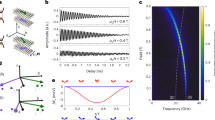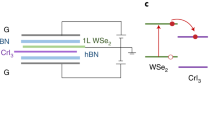Abstract
The recent discoveries of two-dimensional (2D) magnets1,2,3,4,5,6 and their stacking into van der Waals structures7,8,9,10,11 have expanded the horizon of 2D phenomena. One exciting application is to exploit coherent magnons12 as energy-efficient information carriers in spintronics and magnonics13,14 or as interconnects in hybrid quantum systems15,16,17. A particular opportunity arises when a 2D magnet is also a semiconductor, as reported recently for CrSBr (refs. 18,19,20) and NiPS3 (refs. 21,22,23) that feature both tightly bound excitons with a large oscillator strength and potentially long-lived coherent magnons owing to the bandgap and spatial confinement. Although magnons and excitons are energetically mismatched by orders of magnitude, their coupling can lead to efficient optical access to spin information. Here we report strong magnon–exciton coupling in the 2D A-type antiferromagnetic semiconductor CrSBr. Coherent magnons launched by above-gap excitation modulate the exciton energies. Time-resolved exciton sensing reveals magnons that can coherently travel beyond seven micrometres, with a coherence time of above five nanoseconds. We observe these exciton-coupled coherent magnons in both even and odd numbers of layers, with and without compensated magnetization, down to the bilayer limit. Given the versatility of van der Waals heterostructures, these coherent 2D magnons may be a basis for optically accessible spintronics, magnonics and quantum interconnects.
This is a preview of subscription content, access via your institution
Access options
Access Nature and 54 other Nature Portfolio journals
Get Nature+, our best-value online-access subscription
$29.99 / 30 days
cancel any time
Subscribe to this journal
Receive 51 print issues and online access
$199.00 per year
only $3.90 per issue
Buy this article
- Purchase on Springer Link
- Instant access to full article PDF
Prices may be subject to local taxes which are calculated during checkout





Similar content being viewed by others
Data availability
The data that support the plots within this paper are available from the corresponding author upon reasonable request. Source data are provided with this paper.
References
Lee, J.-U. et al. Ising-type magnetic ordering in atomically thin FePS3. Nano Lett. 16, 7433–7438 (2016).
Gong, C. et al. Discovery of intrinsic ferromagnetism in two-dimensional van der Waals crystals. Nature 546, 265–269 (2017).
Huang, B. et al. Layer-dependent ferromagnetism in a van der Waals crystal down to the monolayer limit. Nature 546, 270–273 (2017).
Gibertini, M., Koperski, M., Morpurgo, A. F. & Novoselov, K. S. Magnetic 2D materials and heterostructures. Nat. Nanotechnol. 14, 408–419 (2019).
Gong, C. & Zhang, X. Two-dimensional magnetic crystals and emergent heterostructure devices. Science 363, eaav4450 (2019).
Mak, K. F., Shan, J. & Ralph, D. C. Probing and controlling magnetic states in 2D layered magnetic materials. Nat. Rev. Phys. 1, 646–661 (2019).
Zhong, D. et al. Layer-resolved magnetic proximity effect in van der Waals heterostructures. Nat. Nanotechnol. 15, 187–192 (2020).
Tang, C., Zhang, Z., Lai, S., Tan, Q. & Gao, W. Magnetic proximity effect in graphene/CrBr3 van der Waals heterostructures. Adv. Mater. 32, 1908498 (2020).
Tong, Q., Liu, F., Xiao, J. & Yao, W. Skyrmions in the moiré of van der Waals 2D magnets. Nano Lett. 18, 7194–7199 (2018).
Huang, B. et al. Emergent phenomena and proximity effects in two-dimensional magnets and heterostructures. Nat. Mater. 19, 1276–1289 (2020).
Wang, C., Gao, Y., Lv, H., Xu, X. & Xiao, D. Stacking domain wall magnons in twisted van der Waals magnets. Phys. Rev. Lett. 125, 247201 (2020).
Zhang, X.-X. et al. Gate-tunable spin waves in antiferromagnetic atomic bilayers. Nat. Mater. 19, 838–842 (2020).
Chumak, A. V., Vasyuchka, V. I., Serga, A. A. & Hillebrands, B. Magnon spintronics. Nat. Phys. 11, 453–461 (2015).
Kruglyak, V. V., Demokritov, S. O. & Grundler, D. Magnonics. J. Phys. D 43, 264001 (2010).
Li, Y. et al. Hybrid magnonics: physics, circuits, and applications for coherent information processing. J. Appl. Phys. 128, 130902 (2020).
Lachance-Quirion, D., Tabuchi, Y., Gloppe, A., Usami, K. & Nakamura, Y. Hybrid quantum systems based on magnonics. Appl. Phys. Express 12, 70101 (2019).
Awschalom, D. D. et al. Quantum engineering with hybrid magnonic systems and materials. IEEE Trans. Quantum Eng. 2, 1–36 (2021).
Telford, E. J. et al. Layered antiferromagnetism induces large negative magnetoresistance in the van der Waals semiconductor CrSBr. Adv. Mater. 32, 2003240 (2020).
Lee, K. et al. Magnetic order and symmetry in the 2D semiconductor CrSBr. Nano Lett. 21, 3511–3517 (2021).
Wilson, N. P. et al. Interlayer electronic coupling on demand in a 2D magnetic semiconductor. Nat. Mater. 20, 1657–1662 (2021).
Kang, S. et al. Coherent many-body exciton in van der Waals antiferromagnet NiPS3. Nature 583, 785–789 (2020).
Hwangbo, K. et al. Highly anisotropic excitons and multiple phonon bound states in a van der Waals antiferromagnetic insulator. Nat. Nanotechnol. 16, 655–660 (2021).
Wang, X. et al. Spin-induced linear polarization of photoluminescence in antiferromagnetic van der Waals crystals. Nat. Mater. 20, 964–970 (2021).
Mak, K., Lee, C., Hone, J., Shan, J. & Heinz, T. Atomically thin MoS2: a new direct-gap semiconductor. Phys. Rev. Lett. 105, 136805 (2010).
Splendiani, A. et al. Emerging photoluminescence in monolayer MoS2. Nano Lett. 10, 1271–1275 (2010).
Němec, P., Fiebig, M., Kampfrath, T. & Kimel, A. V. Antiferromagnetic opto-spintronics. Nat. Phys. 14, 229–241 (2018).
Kumar, A. T. N., Rosca, F., Widom, A. & Champion, P. M. Investigations of amplitude and phase excitation profiles in femtosecond coherence spectroscopy. J. Chem. Phys. 114, 701–724 (2001).
Lüer, L. et al. Coherent phonon dynamics in semiconducting carbon nanotubes: a quantitative study of electron–phonon coupling. Phys. Rev. Lett. 102, 127401 (2009).
MacNeill, D. et al. Gigahertz frequency antiferromagnetic resonance and strong magnon–magnon coupling in the layered crystal CrCl3. Phys. Rev. Lett. 123, 47204 (2019).
Shen, X. et al. Multi-domain ferromagnetic resonance in magnetic van der Waals crystals CrI3 and CrBr3. J. Magn. Magn. Mater. 528, 167772 (2021).
Gurevich, A. G. & Melkov, G. A. Magnetization Oscillations and Waves (CRC, 1996).
Scheie, A., Ziebel, M., Chica, D. G., Bae, Y. J., Wang, X., Kolesnikov, A. I., Zhu, X., Roy, X., Spin Waves and Magnetic Exchange Hamiltonian in CrSBr. Adv. Sci. https://doi.org/10.1002/advs.202202467 (2022).
Shen, K. & Bauer, G. E. W. Theory of spin and lattice wave dynamics excited by focused laser pulses. J. Phys. D 51, 224008 (2018).
Ogawa, N. et al. Photodrive of magnetic bubbles via magnetoelastic waves. Proc. Natl Acad. Sci. USA 112, 8977–8981 (2015).
Dany, L.-Q. et al. Entanglement-based single-shot detection of a single magnon with a superconducting qubit. Science 367, 425–428 (2020).
Yutaka, T. et al. Coherent coupling between a ferromagnetic magnon and a superconducting qubit. Science 349, 405–408 (2015).
Lee, K. et al. Magnetic order and symmetry in the 2D semiconductor CrSBr. Nano Lett. 21, 3511–3517 (2021).
Wilson, N. P. et al. Interlayer electronic coupling on demand in a 2D magnetic semiconductor. Nat. Mater. 20, 1657–1662 (2021).
Němec, P., Fiebig, M., Kampfrath, T. & Kimel, A. V. Antiferromagnetic opto-spintronics. Nat. Phys. 14, 229–241 (2018).
Shen, K. & Bauer, G. E. W. Laser-induced spatiotemporal dynamics of magnetic films. Phys. Rev. Lett. 115, 197201 (2015).
Ogawa, N. et al. Photodrive of magnetic bubbles via magnetoelastic waves. Proc. Natl Acad. Sci. USA 112, 8977–8981 (2015).
Toth, S. & Lake, B. Linear spin wave theory for single-Q incommensurate magnetic structures. J. Phys. Condens. Matter 27, 166002 (2015).
Holstein, T. & Primakoff, H. Field dependence of the intrinsic domain magnetization of a ferromagnet. Phys. Rev. 58, 1098–1113 (1940).
Acknowledgements
The spectroscopic and imaging work was supported by the Materials Science and Engineering Research Center (MRSEC) through NSF grant DMR-2011738, with partial support for experimental apparatus by the Vannevar Bush Faculty Fellowship through the Office of Naval Research grant number N00014-18-1-2080. The synthesis of the CrSBr crystals was supported as part of Programmable Quantum Materials, an Energy Frontier Research Center funded by the US Department of Energy (DOE), Office of Science, Basic Energy Sciences (BES), under award DE-SC0019443. The magnetic resonance spectroscopy work was supported by the Air Force Office of Scientific Research under grant FA9550-19-1-0307. The magnetic-field-dependent experiment in Fig. 2c was supported by the Department of Energy, Basic Energy Sciences, Materials Sciences and Engineering Division (DE-SC0012509). The vibrating sample magnetometry was purchased with financial support from the NSF through a supplement to award DMR-1751949. This research used resources at the Spallation Neutron Source, a DOE Office of Science User Facility operated by the Oak Ridge National Laboratory. This research was supported by an appointment to the Intelligence Community Postdoctoral Research Fellowship Program at University of Washington administered by Oak Ridge Institute for Science and Education (ORISE) through an interagency agreement between the US Department of Energy and the Office of the Director of National Intelligence (ODNI). We are grateful to K. Lee, T. Handa and Y. Dai for providing help and discussions.
Author information
Authors and Affiliations
Contributions
X.Z. and Y.J.B. conceived this work. Y.J.B. carried out all optical measurements at fixed magnetic fields with assistance from J.W., Y.B. and M.D. Bulk crystals were synthesized and characterized by D.G.C. and M.E.Z. under the supervision of X.R. and C.R.D. The magnetic resonance measurements were carried out by Y.J.B., J.X. and H.R. under the supervision of A.D.K. The magnetic-field-dependent optical measurements were performed by G.M.D. and J.C. under the supervision of X.X. Theoretical analysis was performed by Y.J.B. and A.S. X.Z. supervised the project. The manuscript was prepared by Y.J.B. and X.Z. in consultation with all other authors. All authors read and commented on the manuscript.
Corresponding author
Ethics declarations
Competing interests
The authors declare no competing interests.
Peer review
Peer review information
Nature thanks Jun-Bo Han and the other, anonymous, reviewer(s) for their contribution to the peer review of this work.
Additional information
Publisher’s note Springer Nature remains neutral with regard to jurisdictional claims in published maps and institutional affiliations.
Supplementary information
Supplementary Information
This file contains Supplementary Sections 1–15, including Supplementary Figs. 1–23, Tables 1–5 and References. The sections include supplementary data, including temperature-dependent, pump-power-dependent and zero-field transient reflectance spectra, calculations of exciton energy modulation in bulk and a few-layer samples, temperature-dependent antiferromagnetic resonance spectra and analysis using Landau–Lifshitz equations 1–18 and linear spin-wave theory, coherent magnon propagation data and group velocity analysis, magnon–phonon coupling in the frequency domain, magnon coherence time analysis, optical and atomic force microscopy images of samples, optical set-up including transient reflectance and magneto-optical Kerr effect, and anisotropy field calculations from vibrating sample magnetometry at variable temperatures.
Rights and permissions
About this article
Cite this article
Bae, Y.J., Wang, J., Scheie, A. et al. Exciton-coupled coherent magnons in a 2D semiconductor. Nature 609, 282–286 (2022). https://doi.org/10.1038/s41586-022-05024-1
Received:
Accepted:
Published:
Issue Date:
DOI: https://doi.org/10.1038/s41586-022-05024-1
This article is cited by
-
Dipolar spin wave packet transport in a van der Waals antiferromagnet
Nature Physics (2024)
-
Terahertz field-induced nonlinear coupling of two magnon modes in an antiferromagnet
Nature Physics (2024)
-
Terahertz-field-driven magnon upconversion in an antiferromagnet
Nature Physics (2024)
-
Electric control of optically-induced magnetization dynamics in a van der Waals ferromagnetic semiconductor
Nature Communications (2024)
-
Systematic determination of a material’s magnetic ground state from first principles
npj Computational Materials (2024)
Comments
By submitting a comment you agree to abide by our Terms and Community Guidelines. If you find something abusive or that does not comply with our terms or guidelines please flag it as inappropriate.



